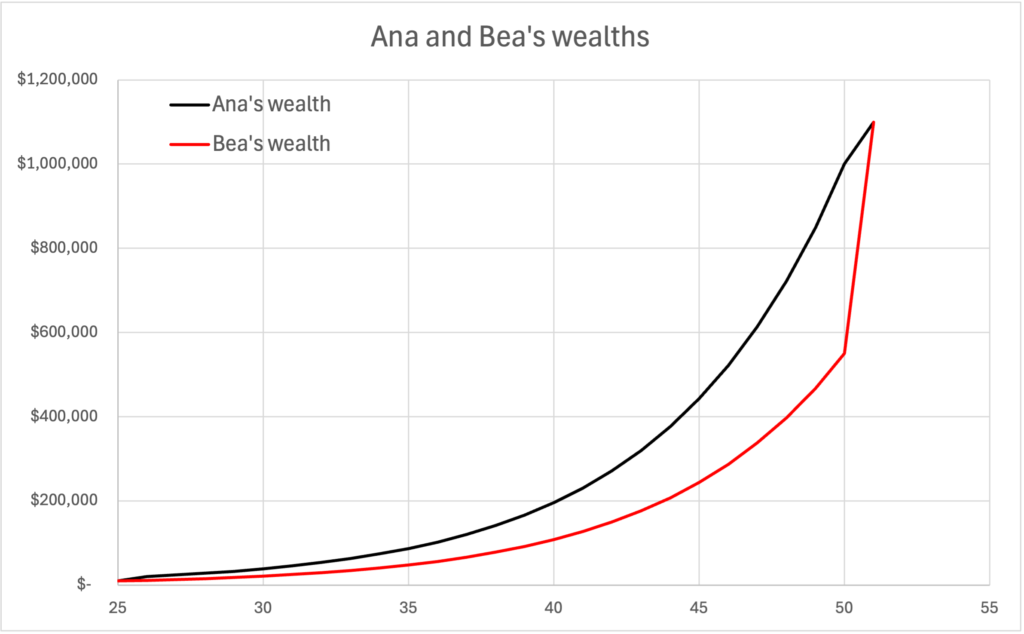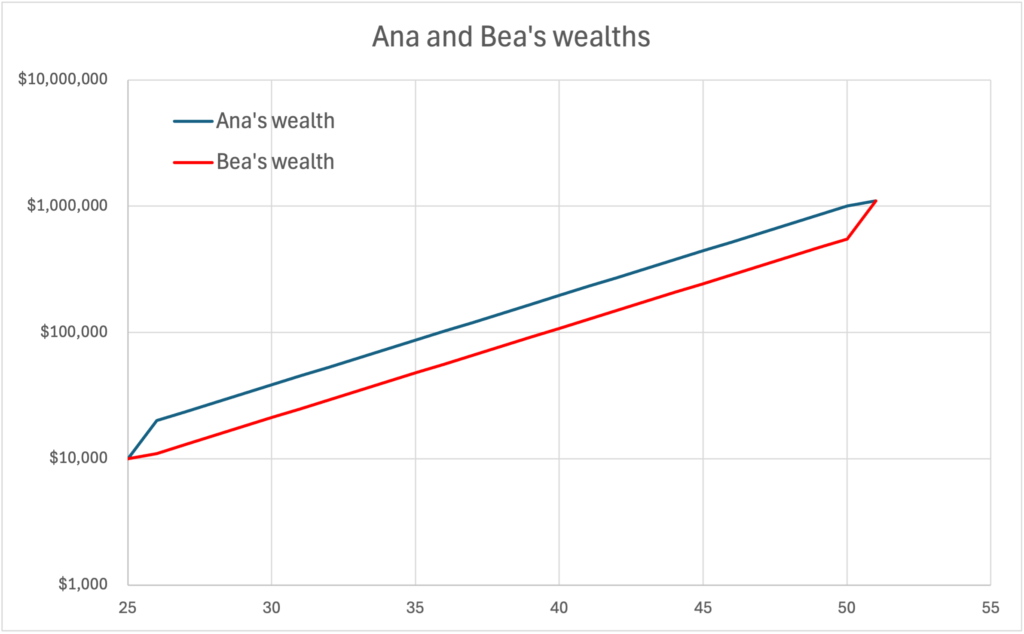Imagine that in one year our wealth grows 100% (doubles), and in another year it grows 10%. These don’t have to be consecutive years. Does it matter in what order these years happen? The answer is yes and no.
- Why no? It does not matter to our long-term wealth whether it grew 100% first and 10% later, or 10% first and 100% later. We end with the same number. To give an example, one person starts with a wealth of $100,000, doubles it to $200,000 then gains another 10% to end at $220,000. Another person also starts with $100,000, gains 10% to go to $110,000, then doubles it to reach $220,000. Both started with the same amount and ended with the same amount as well.
- Why yes? Because it makes a big difference to our wellbeing. A person whose wealth grows rapidly in young age then slowly in old age lives their life as a wealthy person. Another person whose wealth grows slowly at first then rapidly later lives a poorer life, even though they both end with the same wealth.
The conclusion is that growing wealth earlier in life leads to a better quality of life. In an earlier post, I introduced the journey of wealth, which says that a person goes through the stages of Dependence (D), followed by Earning (E), and lastly Financial Freedom (F), or D -> E -> F. Our conclusion here applies to the early years of stage E. Note that the growth of wealth is stated in percentages, not in dollars. How can we use this conclusion to benefit us? Let us see with an example.
Ana, who is 25 years old, has a wealth of $10,000. Ana can save $10,000 the following year to achieve 100% wealth growth early in life. Years later at age 50, when Ana has a million dollars, a 10% return in one year grows her $1 million to $1.1 million. This corresponds to the numbers in the example we started with.
Bea, the same age as Ana, also started with $10,000 in the same year. But next year when Ana saved $10,000, Bea could save only $1,000. After that one year, though, their wealths grew at the same rate (about 17.7% annualized). At age 50, when Ana just became a millionaire, how much did Bea have? She had $550,000. The difference of Ana’s and Bea’s fortunes – $1 million vs. $0.55 million – is entirely due to that one year when they were both 25 years old. That year, Ana had saved ten grand and Bea only saved one. At age 50, Bea would have to double her wealth to catch up to Ana by the next year.
When we are young and have little wealth, achieving a high wealth growth rate is easy. Why? Because growth rate is calculated by dividing with starting wealth. Because starting wealth is small, the growth rate as a percentage can be large. This is one mathematical reason why poor frugal people get ahead. They save when they have very little wealth. It’s like the timeless tale of the high-earning thriftless hare vs. the low-earning frugal tortoise. The difference is that, in this story, the tortoise builds an early lead by saving, and the hare never catches up.
We see Ana’s and Bea’s wealths on the chart below. their wealth gap widens as the years go from 25 to 50.

But if we plot the same wealths with a log wealth-axis, it shows (as we know) that their wealths grew at the same rate (parallel lines) except at age 25, “and that has made all the difference” (to paraphrase Robert Frost).

In fact, Ana could have spent ten thousand dollars more every year from age 41 to 50, and she would still have been worth $768,189 at age 50, considerably wealthier than Bea. We see this below. Save a dollar now. Spend more than ten later.

Was Bea utterly doomed by her inability to save in one year? Clearly not. She could have saved the next year, the year after, and so on. In fact, if she saved the same dollar amount as Ana at age 26, 27 etc., then her wealth growth rate would have been higher than Ana’s, and she would have caught up to a significant extent.
One common frustration of financial planners and investment advisors is that seniors with insufficient wealth come to them asking if they have enough to live their remaining years. Deep down, these senior clients know that their money won’t last, that they cannot retire, and it makes them unhappy, afraid and vulnerable. While an honest financial planner would state the hard truth, an inexperienced or unscrupulous planner/advisor might say what the senior client wants to hear, leading them on a downward spiral. It is so much better to grow wealth early, and not get into such a position of vulnerability.
Thanks for reading. If you like my writing, please share my blog and consider following me on Twitter.
